Table of Contents
ToggleIntroduction
Gigabyte was about four to six weeks later to the market than many other “big players” with their KT133A board, the GA-7ZXR (Rev. 2.1). But unlike Asus, Abit and MSI for example, they made a lot of changes to the vanilla GA-7ZXR (Rev. 1.x), their previous KT133 offering. From Revision 2.1 and up, the GA-7ZXR features the newer VIA KT133A chipset.
The key changes (besides the newer chipset) were a 3-phase VRM instead of the 2-phase VRM that the Rev 1.x board had, and the inclusion of multiplier and voltage adjustments through a series of new DIP switches.
Unfortunately, Gigabyte release quite some variants within the “GA-7ZX” line of boards, which can carry either the KT133 or KT133A chipset. Sometimes, as with the GA-7ZXR, the chipset was updated (along with other changes as mentioned above) without changing the name of the board.
Furthermore, it seems like Rev. 2.1 boards were the first to have the newer KT133A chipset, but revision 2.0 boards still had the older KT133 installed. This is very confusing, obviously even for Gigabyte themselves - which we will see later in the “documentation” section.
I'll try to list all the available KT133A models along with some information I could gather:
- GA-7ZX-H (rev. 5.1) = VIA KT133A/686B chipset
Similar to the older GA-7ZX-1, which was a cut down GA-7ZX variant. Chipset updated from KT133 to KT133A compared to the GA-7ZX-1.
- GA-7ZXC = VIA KT133A/686B chipset
Budget/UltraLowCost
- GA-7ZXE = VIA KT133A/686B chipset
Budget/UltraLowCost, Follow-up to GA-7ZXC
- GA-7ZXR (rev. 2.1 and up) = VIA KT133A/686B chipset
Changes compared to Rev. 1.1: ISA Slot removed, multiple OC options added (via DIP Switches), 3-phase instead of 2-phase VRM
- GA-7ZXR (rev. 3.x) = VIA KT133A/686B chipset
Changes compared to Rev. 2.x: Active Northbridge Cooling
- GA-7ZXR-C (rev. 3.x) = VIA KT133A/686B chipset
Presumely cut down version of the GA-7ZXR (3.x), though specs look completely identical
Gallery
Specifications and Features
Chipset:
- VIA KT133A Northbridge
- VIA 686B Southbridge
CPU Support (with latest BIOS):
- Athlon Thunderbird (ALL)
- Athlon XP Palomino (ALL)
- Duron Spitfire (ALL)
- Duron Morgan (ALL)
Memory Support:
- 3 SDR DIMM slots, up to 1,5 GB total
Expansion Slots:
- 1x AGP slot (1,5 / 3,3V) up to 4x
- 6x PCI slots
- 1x AMR slot
Connectors (internal):
- 2x IDE (UDMA100)
- 1x Floppy
- 2x USB 1.1
- 3x 3-pin fan connectors total (1x CPU, 2x chassis)
Connectors (external):
- 2x PS/2
- 2x COM/RS-232
- 1x Parallel Port
- 2x USB 1.1
- 3x 3,5" Audio Jacks (Line-Out, Line-In, Mic)
- Gameport
Other than most motherboards of that time, this one actually has a relatively decent audio chip onboard, which is the Creative CT5880. This is essentially a Soundblaster 128 PCI, which is definitely a step up in performance and compatibility compared to your average Realtek or C-Media chipset. Still, a decent chip does not make a good soundcard, as the remaining parts responsible for the analog audio output play an important role on how good it sounds. A dedicated soundcard will always be the best solution.
Very commonly recommended are the Creative Soundblaster Live! cards for example, which offer fantastic compatibility with our beloved old games and sound far better than any onboard solution of that era.
I also don't list (from a retro-gamers perspective) useless connectors and features like IR, Smartcard- or Wake-on-LAN connectors and so on.
Overclocking Features:
- Adjustable Multiplier (DIP switch) from x5 - x12,5
- Adjustable FSB (DIP switch) 30 settings, some of them are only found inside the manual
- Adjustable FSB (BIOS) 95-120 and 133-200 MHz in 1 MHz steps
- Adjustable VCore (DIP switch) 1,500 to 1,850 V in 0,025 V steps
- DDR Voltage (DIP switch) 3,3 / 3,4 / 3,5 V
- AGP Voltage (DIP switch) 1,5 / 1,6 / 1,7 V
The GA-7ZXR has a wide variety of OC options, which can, except for the FSB, be configured by DIP switches only. You even have to pre-select the FSB (100/133 MHz) that suits your CPU by jumper first, before you can then set the FSB speed in 1 MHz increments from within the BIOS (or alternatively by DIP switch if you so desire).
Documentation, Downloads, Drivers
Since Gigabyte is still around today, finding needed files and information like BIOS updates, a CPU support list, the manual or drivers is refreshingly straightforward.
The support site for the GA-7ZXR can be found easily when you go to your search engine of choice and type "ga-7zxr support". No matter if you follow the link for the GA-7ZXR 1.x, 2.x or 3.x, you will be directed to the same support site, where you can select the revision that fits your board.

Gigabyte offers the latest for BIOS versions including the final BIOS “FB” for download. The required flashtool as well as a pre-configured autoexec.bat file is also included in the download, so you only have to put the contents of the archive on your bootable floppy, boot from it and the flashtool starts automatically. All you have to do is confirm the preselected BIOS file and the flash process itself.
The manual and a CPU support list can also be found on the support site.
The manual is of okay quality, but does not offer too much information that cannot be gathered from the imprints found on the PCB. On the other hand, due to the large amount of DIP switches and jumpers, it might be easier to get a first overview of the settings by looking in the manual than by searching over the PCB to collect all the information.
The CPU support list is another story, however. Like mentioned in the introduction of this review, Gigabyte changed the chipset from the KT133 to the KT133A with the board revision 2.1, without changing the name.
Presumely because the Rev. 2.0 boards still featured the VIA KT133 (from what I found online “Bis zur Revision 2.0 wurde noch der Vorgänger KT133 verbaut” = “Until revision 2.0, the predecessor KT133 was still being used”), the CPU Support List on Gigabyte's website is incorrect. According to the list found there, all Rev. 2.x boards only support FSB100 CPUs, which is plain wrong.
Firstly, I have never heard from or seen any KT133A board that can't run FSB133 CPUs and secondly, I successfully tested an Athlon XP 2100+ Palomino on my GA-7ZXR Rev. 2.1:

It was detected correctly, the correct VCore was applied and I was able to run some short benches without issues.
In the drivers section of the support site, there are drivers for the Creative audio chip, the promise RAID chip, as well the VIA 4in1 drivers available. The version of the VIA driver (4.43) is not the most recent but fits the older chipset, the Promise driver is rather old, the CT5880 (SB128 PCI) driver should be pretty recent. Alternatively, regular Creative Soundblaster 128 PCI drivers should work (I didn't test that). If your board has the additional RAID chip (which mine doesn't), I recommend to download the latest driver the manufacturer's website: https://www.promise.com/Support/downloadcenter

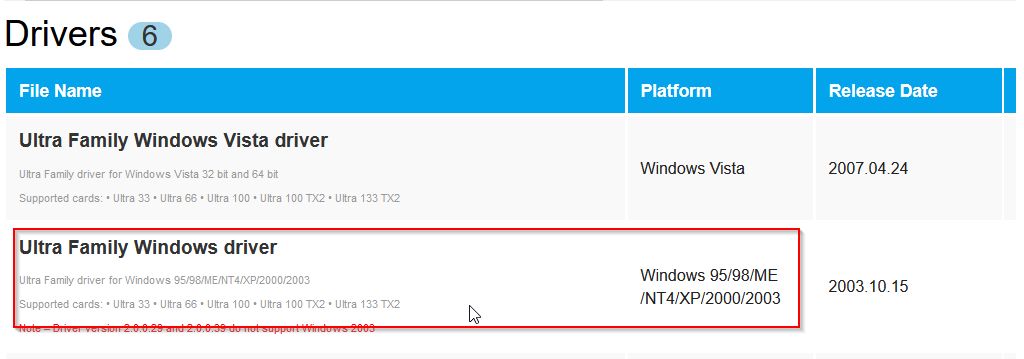
Design & Layout
The overall layout of the GA-7ZXR is very tidy and clean looking. Even though there are lots of DIP switches on the board, they are at least positioned in a way, that they should still be accessible when the system is fully assembled. The jumper for the FSB 100/133 MHz selection (JP21) however, is placed so close to the memory slots, that it is very hard to change the setting with your fingers, even when the board is on a testbench. For me (I have very “stable” fingers 😉 ) it is impossible to do it without a tool.

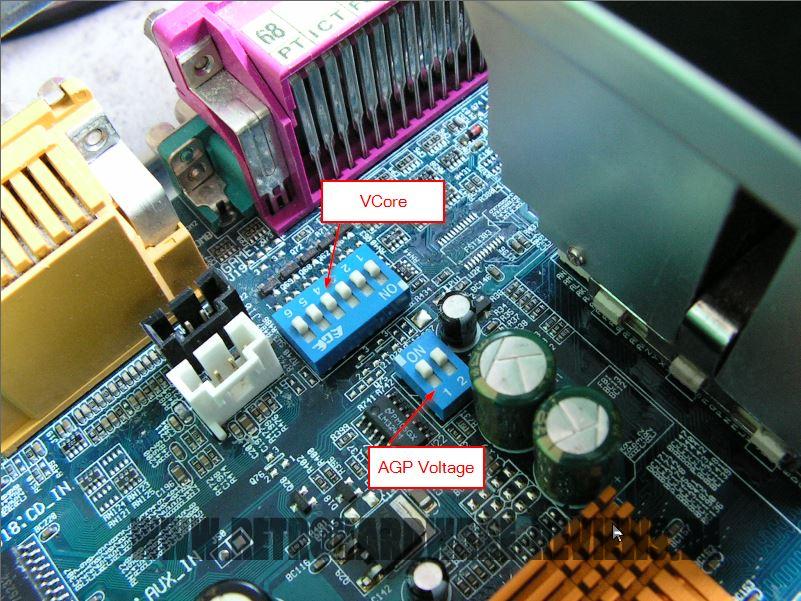

In the same spot, we can find the ATX power connector. In this position, it is quite easy to route the ATX power cable in a way that it doesn't affect the aiflow. The IDE and floppy connectors are also in this area, which is ideal in my opinion.


Gigabyte's KT133A board offers plenty of space around the CPU socket, so that coolers of any size should fit. To put this to a test, I tested the following seven coolers towards compatibility:
- Thermaltake Silent Boost K7
- Cooler Master HHC-001
- Swiftech MCX 370
- Alpha PAL 6035
- Alpha PAL 8045
- Smartcooler 60mm
- Arctic Cooling Copper Lite

Although the CPU socket of the GA-7ZXR is not quite as close to the top edge of the board as on the GA-7DXR for example, it is still close enough to have the Cooler Master HHC-001's lever reach over the edge of the PCB. All other coolers could be installed without a sweat, but I discovered an interesting compatibility problem, which I did not experience on any other board before: The Alpha PAL 8045 blocks the CPU fan connector.
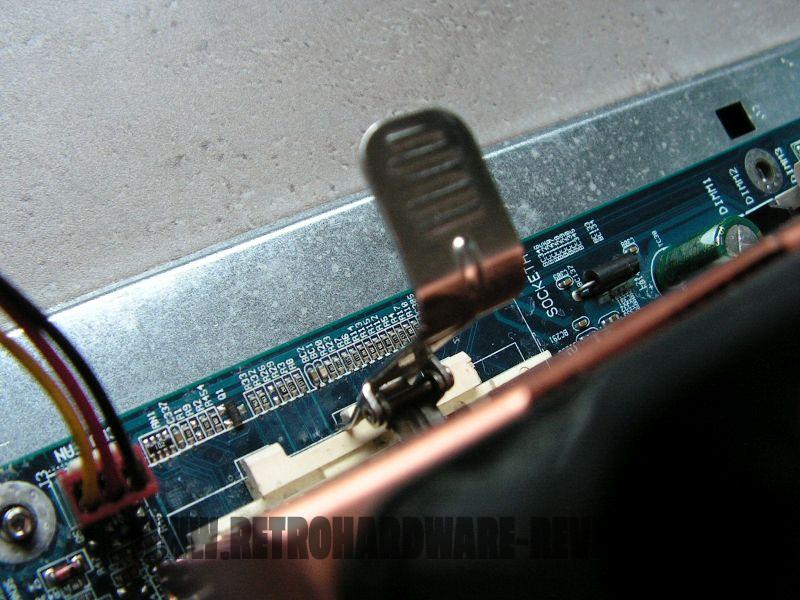
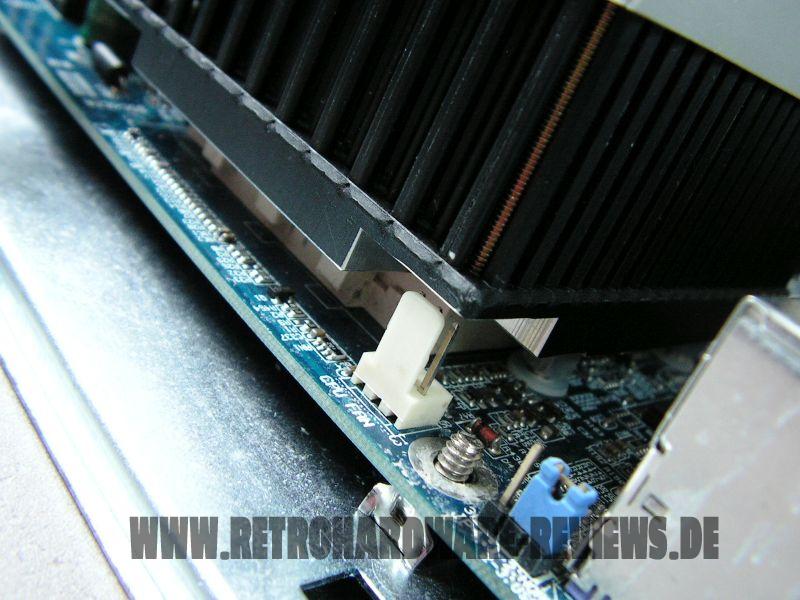
While you can alternatively use a casefan connector for it, it is still a thing you don't get to see very often. The fan connector in the upper right corner is very poorly placed for connecting a case fan anyway, so it's not a big loss. Fortunately, at least the second case fan connector is positioned perfectly in the lower right corner. This area is quite well laid out overall, even long PCI cards will hardly block access to the CMOS battery or the ports located there.
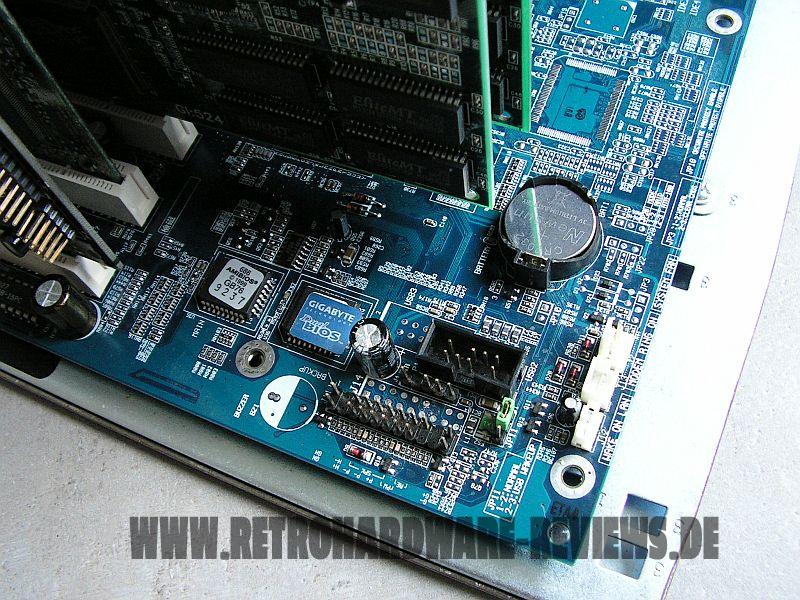
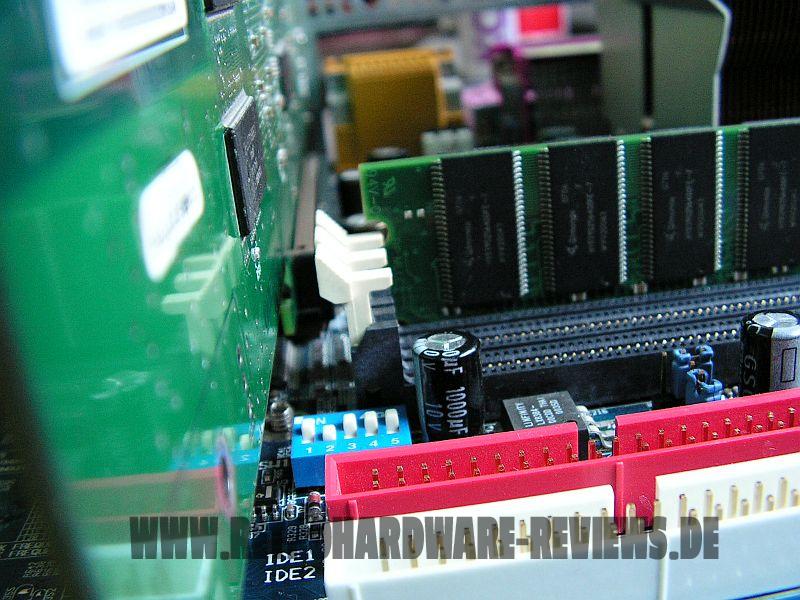
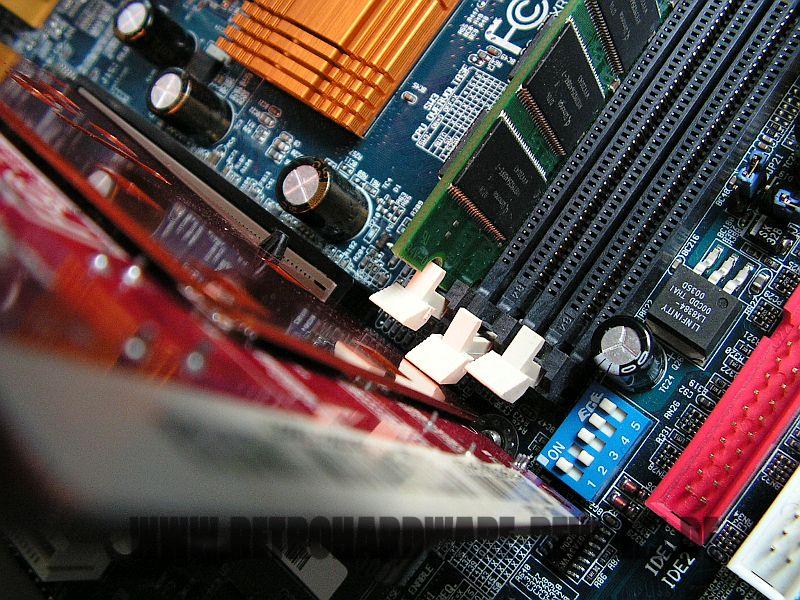
But an issue that the GA-7ZXR shares with many boards of that era, is that the AGP card blocks access to the memory slots. While the distance is big enough to remove a memory stick, the graphics card definitely needs to be removed to install one. This is even more true, if the videocard has a backplate installed, like the MSI GeForce 4 Ti 4200 that I used during the review.
Test-System and Parts
Baseline Setup:
- CPU: AMD Athlon Thunderbird 1200C (FSB133)
Because I want to compare 1st Gen Socket A mainboards to their DDR follow-ups I have to use a CPU, which is available in FSB100 and FSB133 versions with the same clockspeed. Since I sadly don't have a Thunderbird 1400 B at my disposal, I will use the Thunderbird 1200 for my reviews and comparisons of these boards, which I have in the “B” (FSB100) and “C” (FSB133) version.
- RAM: 1x “Infineon 3rd” 512 MB PC133 SD-RAM
This memory stick has Qimonda chips rated at 7ns (=143 MHz). It runs flawlessly with the tightest timings at 133 MHz and its size of 512MB is the perfect choice for Windows 98SE.
- VGA: MSI Geforce 4 TI4200-VTD8X
To remove any GPU bottleneck for testing, I chose a Geforce 4 Ti as the primary graphics card for my test setups. The Geforce 4 Ti series are also known to pull a lot of power from the AGP port, so that possible problems in that department can also be revealed. It is also somewhat period correct and a good match for a high performance retro-machine that should be able to run late Windows 98SE games without any issues.
- VGA2: 3dfx Voodoo 5 5500 AGP
Many people consider the Voodoo 5 5500 the perfect card for (Win9x-) retro gaming. The Voodoo 5 benefits from a beefy setup, so a powerful Athlon Thunderbird or early Athlon XP is the perfect match for this card.
- Audio: Creative Soundblaster Live! (SB0060)
Creative's Soundblaster Live! can be found in many retro-machines. It offers great sound, perfect Win98SE compatibility and is still widely available for reasonable money. It was also known to cause problems with VIA-based 686B southbridges using old BIOS revisions and VIA chipset drivers. All this should be history at this point, but double checking on pontentially affected mainboards is still not a bad thing to do.
- LAN: 3Com Etherlink XL PCI
Just a good, reliable choice for networking. All legacy Windows versions all the way up from Win95 have built-in drivers for it, which is also a huge “plus”.
- HDD: Western Digital WD200BB (20GB 7200RPM)
No special intention behind this drive, it is just “there” and still works fine.
Additional Hardware for certain Tests:
- Silicon Image Sil3512 SATA Controller & Samsung PM871 128GB SSD
These two will help me measure the PCI bandwidth.
- Hitachi Deskstar T7K500 (500GB 7200RPM)
This drive will tell us, how big we can go with the onboard IDE connectors and how the performance is like.
- 2x Voodoo 2 12MB (SLI)
A pair of Voodoo 2s is a must have for any retro-machine, that doesn't feature a 3dfx card as the primary VGA solution. They offer compatibility to older Glide games and can be used with any more powerful primary graphics card. It is an important thing to know, how well these perform and if there are differences between all the available Socket A chipsets of that era or even between boards using the same chipset.
Drivers used:
- Chipset: VIA Hyperion 4in1 4.35v
- Geforce 4: nVidia Forceware 43.45
- Voodoo 5: Amigamerlin 2.9
- Voodoo 2: FastVoodoo 4.6
- SB Live!: Some driver from my archive, not shure 😉
- 3Com NIC: Windows 98SE preloaded driver
- SATA Controller: Some driver from my archive, not shure 😉
System Setup and Usage
After I went through all the DIP settings and checked the jumper settings, I went into the BIOS to configure it for best performance. This is something, that is done pretty fast with the GA-7ZXR, since there are not terribly many options available to do so.
In terms of chipset or memory settings, pretty much all you can do is to activate “Top Performance” and set the CAS Latency to CAS 2 and that's it. This translates into CL2 3-3-6 timings - something I would not necessarily call “Top Performance”. Another option that caught my attention was “Enhance ATAPI Performance”. Unfortunately, this does literally nothing, at least nothing you could see in a HDTach benchmark.
Anyway - when I was through with the BIOS settings, I started determining the sharing between onboard devices and the PCI slots. The manual does not offer any information on that topic, so I figured it out by installing my 3Com NIC into one PCI slot after the other, taking notes on which IRQ got assigned to all listed devices in the POST summary screen.
This is the result:
- PCI #1: no sharing
- PCI #2: shared with onboard audio
- PCI #3: shared with USB
- PCI #4: shared with AGP port
- PCI #5: shared with PCI #1
- PCI #6: shared with PCI #2
Since I wanted to avoid IRQ sharing as good as possible, I had to leave the SATA controller out of the system, until I was finished benching the Voodoo 2 cards. So I disabled all unused onboard components like serial ports, LPT, floppy controller and onboard audio and distributed the expansion cards over the PCI slots like this:
- PCI #1: free
- PCI #2: free
- PCI #3: Voodoo 2
- PCI #4: Voodoo 2
- PCI #5: NIC
- PCI #6: SB Live!
When Windows booted up the first time, I discovered two unkown audio devices in the device manager. Didn't I disable the onboard audio card in the BIOS? I did. But apparently that wasn't enough, I had to disable it by jumper as well. Great.
The installation of all drivers went without problems and I started doing benchmarks. Before I run 3DMark and the UT/Q3 timedemo benches, I usually measure theoretical numbers first, like CPU and memory tests, as well as the AGP performance. And the latter showed abysmal numbers - the AGP throughput was less then half of what I expected from what I saw on other KT133A boards. AGP 4x was reported as enabled, however. When I then got the 3DMark result, which was also not good, and the Q3A timedemo performed a good bit below my expectations, I decided to continue with the Voodoo 2 benches first. These went fine and showed good results.
Next, I installed the Voodoo 5 to see if it shows the same problems I experienced with the Geforce 4 card - and it did to a certain extend. The AGP throughput was the worst I measured yet for a Voodoo 5 and the 3DMark score was also much worse then expected. So there has to be either a BIOS or driver problem, which affects the AGP performance this much.
Since the latest BIOS is not a beta version, I didn't think such a problem wasn't discovered in the QA, so I re-imaged the system and used the older VIA 4.35v 4in1 driver for the chipset. The 4.35v is said to be the best version for “older” VIA chipsets, but since I always used version 4.56v for all VIA based Socket 370 and Socket 462 boards in the past without any issues, i didn't bother to test it on such a platform yet. But it really did the trick - at least for the Geforce 4. The AGP throughput more than doubled, and also the 3D tests showed far better results:
- 3DMark99: +13%
- UT99 timedemos: up to 4%
- Q3A timedemo: +17%
The AGP throughput of the Voodoo 5 however, was still equally bad and the 3DMark score did not improve. But the results of the UT & Q3A timedemos were totally in the range of previously tested KT133A based boards, so I just took it as given. The PCI and IDE performance was identical with both versions of the VIA 4in1 drivers used.
Benchmarks
Synthetic Measurements
Before we get into the 3DMark and gaming benchmarks, let's have a look at some theoretical numbers. These synthetic tests will exhibit the differences between the several chipsets and boards better than any game benchmark and provide us with "background information" that might be of use in understanding the timedemo results later.
Memory Performance: AIDA64 Cache & Memory Benchmark
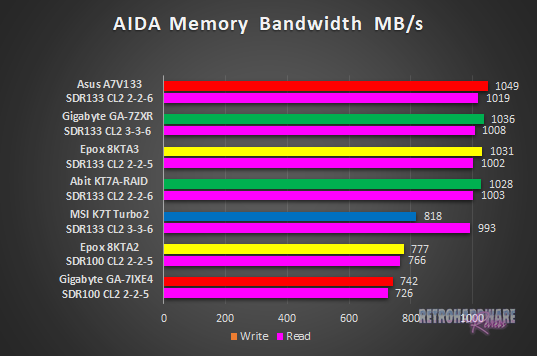
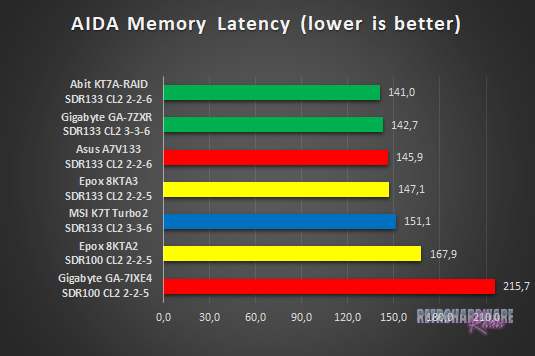
The results for the AIDA memory benchmarks are amazing, considering the slow memory timings. In fact, they are a little "too good" for my taste - which makes me wonder if the reported timings by AIDA and CPU-Z are not correct. Unfortunately, the only timing that is explicitly configurable by the user is the CAS Latency. So I can promise, that "CL2" is correct - for the other timings we have to trust what is reported to us.
Either way - the GA-7ZXR takes second place in the memory bandwith test slightly beating EpoX and Abit; the Asus A7V133 plays dirty with FSB and memory clocked to 134,32 MHz and thus takes the lead.
The memory latency results also look fantastic - the Gigabyte board ranks second again, not far behind the top performing Abit KT7A-RAID.
Application Performance: 7-Zip
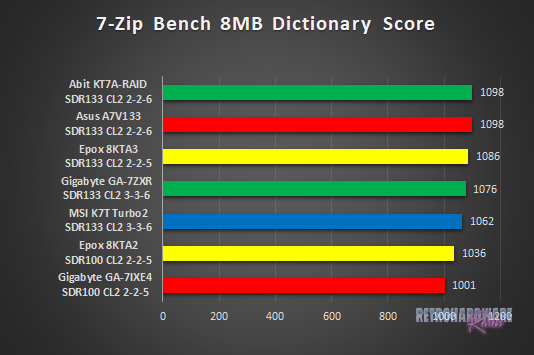
The 7-Zip results are a little disappointing after the what we saw in the AIDA benchmarks. After two second places, I expected the GA-7ZXR to score higher, but it ranks fourth behind Abit, Asus and EpoX.
AGP Performance: Final Reality Benchmark
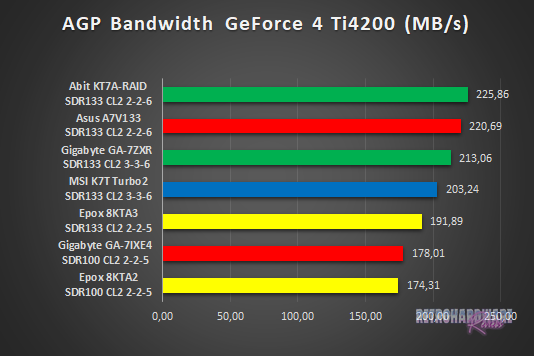

AGP bandwidth looks good for the nVidia card after the fallback to the older VIA chipset driver (see System Setup sction); the GA-7ZXR ranks third with 213,06 MB/s.
The measured bandwidth when combined with a Voodoo 5, however, is still extremely low and the worst of all boards tested. The Asus A7V133 seems to have similar issues, all the other boards show a much higher bandwidth.
AGP and PCI Performance: 3DMark 2000 and ATTO
3DMark 2000 as a whole is very focused on TnL and is by far not as interesting for retro-hardware comparisons as its predecessor. Its “High Polygon Count, 1 Light” test, however, is another good way to measure the AGP performance. In opposite to the Final Reality test, the general system performance is also somewhat of importance. The benchmark was executed with the Geforce 4 Ti installed.
To measure PCI performance, I installed a Windows 98SE compatible SATA controller with a Samsung PM871 128GB SSD connected into the system. For the bench, I chose 1024 to 4096 KB block size and picked the overall best values for the read and write throughput. This test will show, which maximum performance can be expected with fast storage options like SATA or SCSI and maybe gives a hint, if the chipset might be good for Voodoo 2 cards.
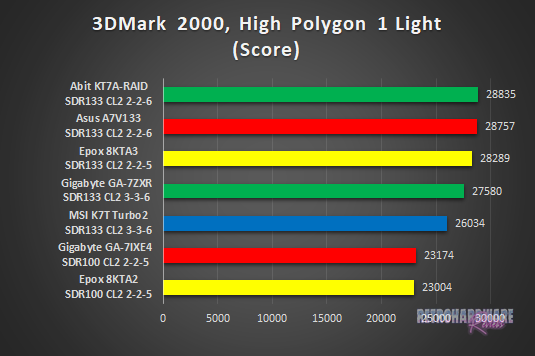
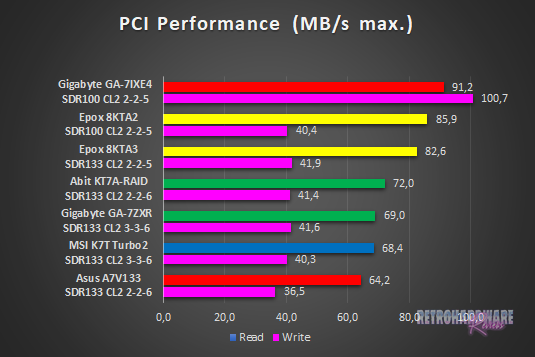
After what we saw in the memory performance tests and the AGP bandwidth measurements for the GeForce 4 Ti, I expected the GA-7ZXR to perform a little better here, in particular better than the EpoX 8KTA3. But the Gigabyte board only reaches fourth place in the 3DMark2000 sub-test.
In the PCI bandwidth test, it shows the same weakness in write throughput, that all VIA KT133(/A) based boards seem to have. Read throughput could also be better, as the two EpoX board show - overall it ranks only fifth here.
Storage Performance: HDTach
To measure the performance of the board's IDE and (if available) onboard IDE RAID solutions' performance, I benched one of the latest and fastest IDE drives (the Hitachi Deskstar T7K500 500GB) with the HDTach benchmark. I also tried a much more “recent” drive (the Western Digital Blue Edition 500GB), which should be even faster in theory, but the Hitachi drive produced much better results in this test.
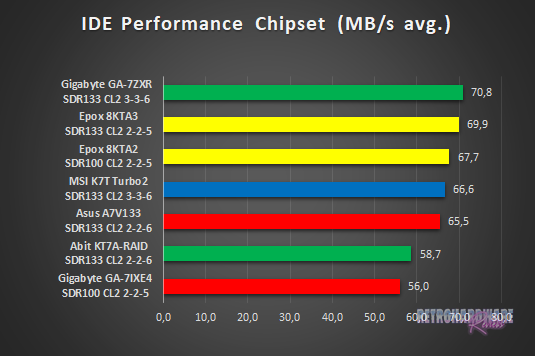
IDE performance is great on Gigabyte's board, taking first place as the only board to crack the 70 MB/s mark.
Gaming Benchmarks
Now that we got all the theoretical performance numbers, let's see how the contenders perform in 3D gaming benchmarks.
3D Performance: 3DMark99max
3DMark99max was released in early 1999 and comes without support for Hardware TnL. The maximum supported (hardware-) DirectX level is DX6. It is a great benchmark to reveal good overall system performance, as it rewards good memory bandwidth and latency more than the slight clockspeed advantage, that some boards have because of their factory-overclocked FSBs.
- Version: "latest"
- Settings: standard
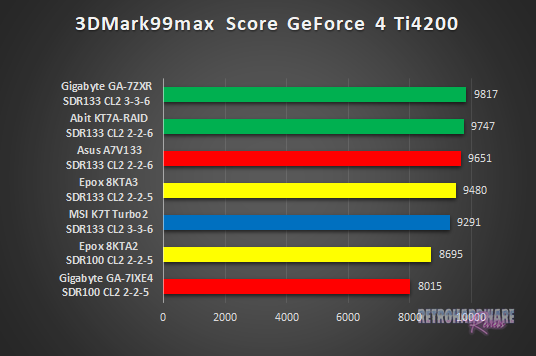
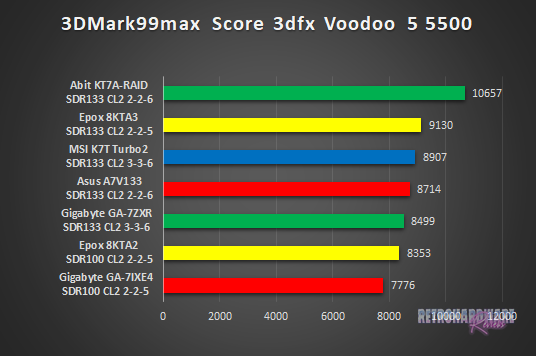
And the GA-7ZXR starts with a bang into the gaming benchmarks, achieving a solid victory in the GeForce 4 Ti run of 3DMark99max. The results for the Voodoo 5 run of 3DMark99max look less bright, however. The missing AGP bandwidth for the 3dfx card is very obvious, the Gigabyte board is the slowest of all KT133A boards and ranks fifth.
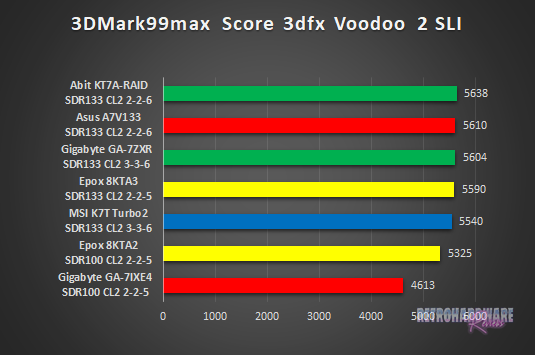
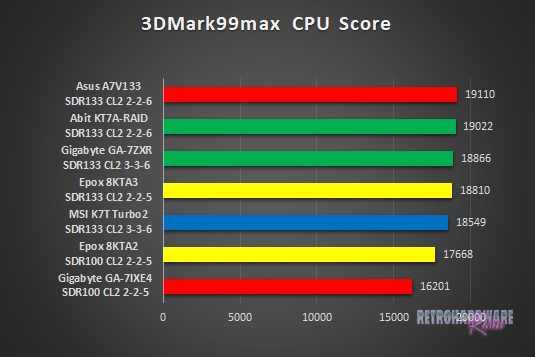
The GA-7ZXR ranks third in the Voodoo 2 SLI run and in terms of CPU score, closely ahead of the EpoX 8KTA3 in both cases.
3D Performance: Unreal Tournament (UT99) Timedemo(s)
Unreal Tournament (UT99) was released in November 1999 and is notorious for its hunger for CPU power. I chose to use two different timedemos for comparison, of which the utbench.dem timedemo is heavily CPU bound and therefore qualifies to measure the general performance of the boards. The second timedemo benchmark.dem is as GPU limited as possible in this game. This will reveal, how much impact a faster board can still have in more GPU limited situations. This game is also perfect to show, on which chipsets and boards Voodoo 2 cards run best.
- Version: 4.36
- Settings: High, Min desired Framerate "0", Show Decals [x], Use Dynamic Lightning [x]
- Geforce: D3D
- Voodoo 2 and Voodoo 5: Glide
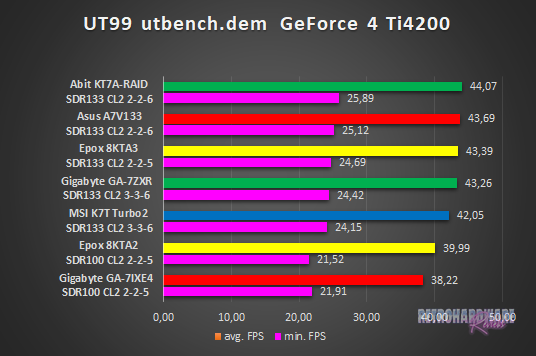
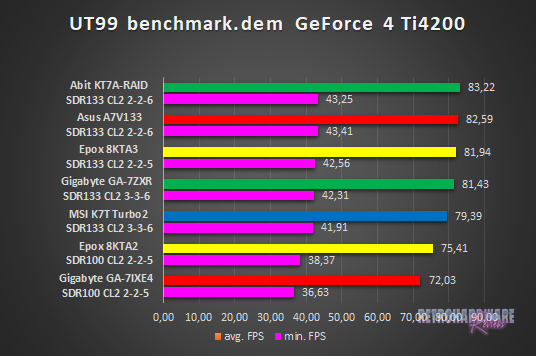
With the GeForce 4 Ti installed, the Gigabyte board takes fourth place in both timedemos, with performance very close to the third-ranked EpoX 8KTA3.
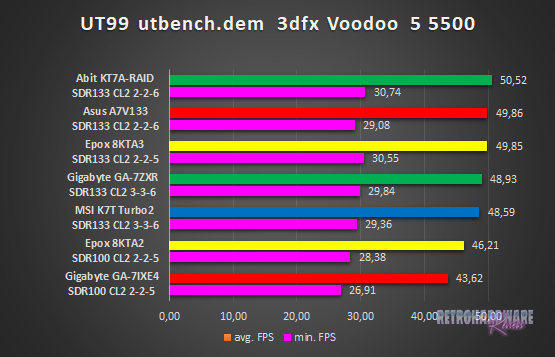
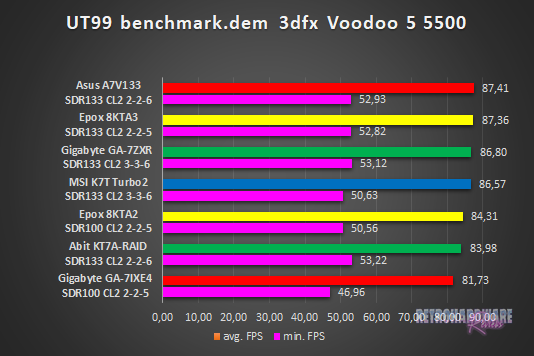
In the Voodoo 5 run of the utbench timedemo, the GA-7ZXR ranks fourth again. This time, the performance is closer to the K7T Turbo2 behind it, than to those in front of it.
The results for the second timedemo look a lot better - it ranks third here and achieves the second highest minimum FPS in this test.
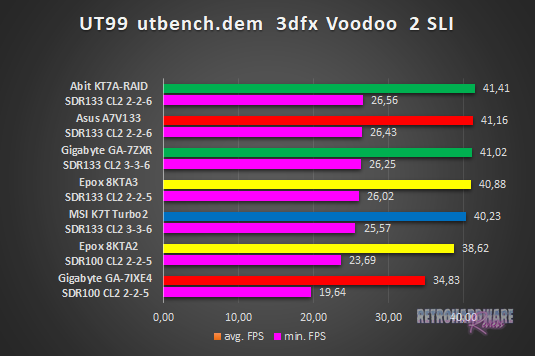
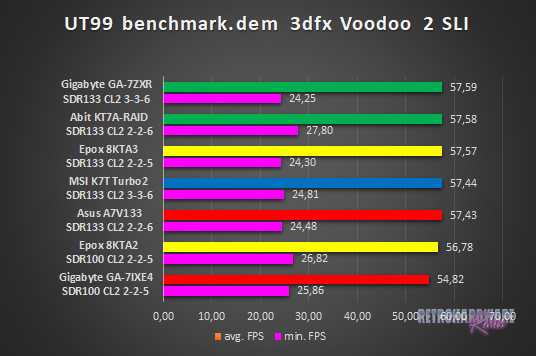
Coming to the Voodoo 2 SLI run of the timedemos, we see very close results in the utbench timedemo between the top three boards, of which the GA-7ZXR takes third place.
It ranks first in the second timedemo, with basicallly identical average FPS to the second and third ranked KT7A-RAID and 8KTA3, but achieves the lowest minimum framerate of all boards, including the EpoX 8KTA2 and the Gigabyte GA-7IXE4 with the older FSB100-only chipsets.
3D Performance: Quake III Arena Timedemo
Quake 3 Arena was released shortly after Unreal Tournament, in December of 1999. It is known to reward fast memory latency and with its normal preset, it is completely CPU limited; at least for the GeForce 4 and the Voodoo 5. The Voodoo 2 SLI cards clearly limit the Athlon 1200 here, as the timedemo will show.
- Version: 1.32
- Settings: “Normal” Preset, only resolution changed to 1024x768x16
- Geforce 5 and Voodoo5: OpenGL
- Voodoo 2: “Voodoo” Renderer (miniGL)
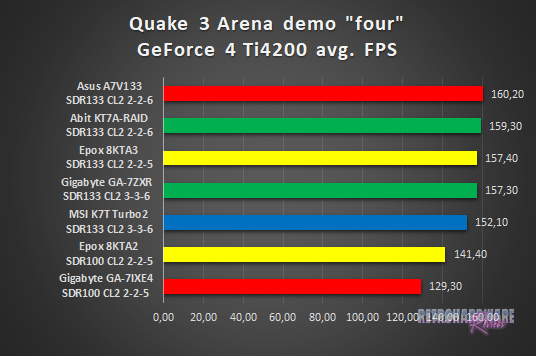
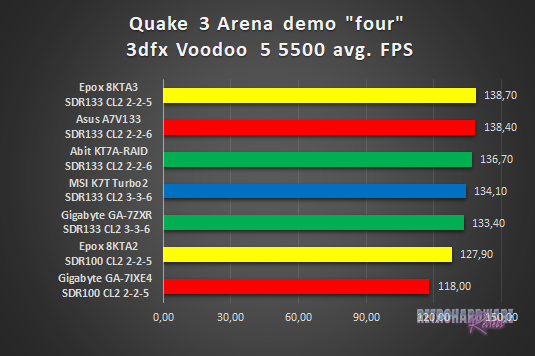
Performance looks okay with the nVidia card, Gigabyte's board ranks fourth with only 0,1 FPS behind the EpoX 8KTA3. The results for the Voodoo 5 run look a lot worse, here the GA-7ZXR falls behind the K7T Turbo2 and is the slowest KT133A based board in the test.
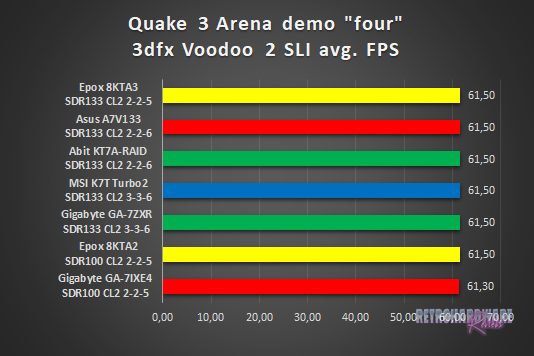
The Voodoo 2 SLI setup clearly limits here. All boards score the same FPS, with only the Gigabyte GA-7IXE4 being a close 0,2 FPS behind.
Summary & Rating
Gigabyte GA-7ZXR (VIA KT133A)
-
Layout
-
Features
-
Overclocking Options
-
Compatibility
-
Documentation & Support
-
Performance: GeForce 4 Ti 4200
-
Performance: Voodoo 5 5500
-
Performance: Voodoo 2 SLI
OVERALL
| Pros | Cons |
| + Decent, tidy layout | – Time-consuming initial setup (DIP switches + FSB jumper) |
| + DUAL BIOS | – Confusing documentation |
| + Creative audio chip | – Fan connector locations |





